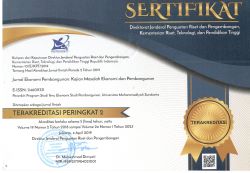FAKTOR-FAKTOR YANG MEMPENGARUHI NILAI TUKAR RUPIAH TERHADAP DOLAR AMERIKA DENGAN MODEL KOREKSI KESALAHAN ENGLE-GRANGER (PENDEKATAN MONETER)
Eni Setyowati(1*)(1) Universitas Muhammadiyah Surakarta
(*) Corresponding Author
Abstract
Exchange rate measures the value of a certain foreign exchange from other foreign exchange's perspective. As the condition of economic changes, the exchange rate ma change substantially. The decrease of the value of a foreign exchange is called depreciation and the increase value of a foreign exchange is called appreciation.
The equilibrium exchange rate will change along with the change of demand and supply. Factors causing the change of demand and supply curve among others are the amount of money supply, relative gross domestic product (GDP) and the level of relative interest rate.
The research is aimed to analyze the influence of variables of Indonesian money supply, American money supply, Indonesian real Gross Domestic Product, American real Gross Domestic Product, deposits interest rate and LIBOR (London Interbank Offer Rates on SDR Deposit) both in short and long terms.
One of the ways to analyze the influence of short term and long term is by developing the dynamic model. In this research, the analyzes of dynamic model was conducted with ENGEL-GRANGER ERROR CORRECTION MODEL approach which was developed by ENGEL-GRANGER (1987) based on GRANGER REPRESENTATION THEOREM.
The ECM analyzes was chosen not only because of its ability to solve the problem of time series which is not stationer, and spurious regression and spurious correlation in the economic analyses but also its ability to discuss the consistence of empiric model with economic theory. Beside, ECM concept is also thought to be more realistic in observing the development of economics variables from the result of the analyzes during the time of observation. It was known that long-term exchange rate is influenced by Indonesia real Gross Domestic Product and the number of Indonesian money supply. The variable of Indonesian real Gross Domestic showed the significant result and the signal test was convenient with the theory. The variable which influence" short term exchange rate are the amount of Indonesian money supply, Indonesian real Gross Domestic Product, and Indonesian deposit interest rate. The three variables showed the significant result and the signal test was convenient with the theory.Keywords
Full Text:
PDFReferences
Adriana, Salomi.1994. Studi Pendekatan Moneter terhadap Kurs Dolar Amerika dan Yen Jepang di Indonesia. 1982. 1 - 1992. IV Skripsi SI. Universitas Gadjah Mada. Yogyakarta. tidak dipublikasikan.
Aliman, 2000. Modul Ekonomika Terapan, Yogyakarta: PAU Studi UGM.
Appleyard, Dennis R dan Field Jr. Alfred J. 1995. International Economics, Irwin.
Babbie, Earl. 1995. The Practice of Social Reseacrh. Seventh Edition. California. USA: Wadsworth Publishing Company.
Baillie, Richard dan Patrick McMahon. 1990. The Foreign Exchange Market: Theory and Economic Evidence. Cambridge: Cambridge University Press.
Batiz, F.L Livera and Luis Livera Batiz. 1985. International Finance and Open Economy Macroeconomics. New York: Mac Millan Publishing Company.
Bank Indonesia. 1998/1999. Laporan Tahunan Bank Indonesia. Jakarta.
Bilson, JF. 1978. The Monetary Approach to Exchange Rate: Some Empirical Evidence. IMF Staff Paper. International Monetary Fund.
Camarazza, Francesco and Jahagir Aziz. 1997. Fixed or Flexible? Getting the Exchange Rate Right in the 1990. 5. World Economic Outlook.
Chow, Edward. H, Wayne Y. Lee, and Michael E. Solt. 1997. The Exchange Rate Risk Exposure of Asset Returns. Journal of Business. Vol.70. No. 1
de Grawe, Paul. 1983, Macroeconomic Theory for The Open Economy, England: Gower Publishing Company Limited.
Deklawan, Hermada 1996. Integrasi Pasar Keuangan Indonesia di Asean Studi Pendekatan Error Correction Model dan Forward Looking Buffer Stock. Skripsi SI. Fakultas Ekonomi Universitas Gadjah Mada Yogyakarta. Tidak dipublikasikan.
Dickey, David and Wayne A. Fuller. 1979. Distribution of the Estimators for Autoregressive Time Series with a Unit Root. Journal of the American Statistical Association.
_______1981. Like Lilihood Ratio Statistics for Autoregressive Time Series with a Unit Root. Econometrica, Vol. 49.
Salvatore, Dominic. 1996. International Economic. New Jersey, USA: Prentice Hall Inc.
Engel, R.F. and C.W. J Granger. 1987. Co-integration and Error Correction Representation, Estimation, and Testing. Econometrica. 251-276
Frenkel, J A. 1976. A Monetary Approach to The Exchange Rate: Doctrinal Aspects and Empirical Evidence. Scandinavian Journal of Economics. Vol. 78. No. 2. 200-224
Gujarati, Damodar N. 1995. Basic Econometrics. Third Edition. Singapore: McGraw-Hill Book Co.
Hallwood, Paul C. Ronald MacDonald. 1994. International Money and Finance. Oxford. UK: Blackwell Publishers Ltd.
Harris, Richard. 1995. Using Cointegration Analysis in Econometric Modelling, Prentice Hall/harvester Wheatsheaf.
Insukindro. 1990a. Komponen Koefisien Regresi Jangka Panjang Model Ekonomi, Sebuah Studi Kasus Impor Barang di Indonesia. Jurnal Ekonomi dan Bisnis Indonesia. Vol. 5. No.2. 1-11
______ 1990b. Penurunan Data Bulanan dari Data Tahunan. Ekonomi dan Keuangan Indonesia. Vol. 38. No. 4. 347-357.
______ 1991. Regresi Linier Lancung dalam Analisis Ekonomi, Suatu Tinjauan dengan Satu Studi Kasus di Indonesia, JEBI. Vol. 6 No. 1.
______ 1992. Dynamic Specification of Demand for Money, a Survey of Recent Development. Journal Ekonomi Indonesia.
______ 1993. Ekonomi Vang dan Bank: Teori dan Pengalaman di Indonesia. Yogyakarta: BPFE.
______ 1996. Pendekatan Masa Depan Dalam Penyusunan Model Ekonometrika Forward Looking dan Pendekatan Kointegrasi. Jurnal Ekonomi Industri. Pusat Antar Universitas (PAU) Universitas Gadjah Mada. Edisi 2 Maret. 1-6
______ 1999. Pemilihan Model Ekonomi Empirik dengan Pendekatan Model Koreksi Kesalahan. Jurnal Ekonomi dan Bisnis Indonesia. Vol. 14. No. 1.1-8
Insukindro dan Aliman. 1999. Pemilihan dan Bentuk Fungsi Model Empirik: Studi Kasus Permintaan Uang Kartal Riil di Indonesia. Jurnal Ekonomi dan Bisnis Indonesia. Vol. 14 No. 4. 49-61.
Ilyas, Akhyar 1999. Alternatif Kebijakan Moneter di Indonesia. Makalah Seminar Nasional HIMISPA. Fakultas Ekonomi. Universitas Gadjah Mada! 1-37.
Isnowati, Sri. 2001. Analisis yang Mempengaruhi Nilai Tukar Rupiah terhadap Dolar Amerika. Pendekatan Moneter 1987.2-1999.1. Tesis S-2 Program Pascasarjana UGM. Tidak dipublikasikan.
Kuncoro, Mudrajat. 1996. Manajemen Keuangan lnternasional: Pengantar Eko-nomi Bisnis Global. Yogyakata: BPFE.
Kirana Jaya, W. 1990. Seleksi Model Permintaan Uang di Indonesia 1973-1987. Jurnal Ekonomi dan Bisnis Indonesia. No. 2. Tahun V. 37-47.
Mac. Donald, R dan Taylor. M. P. 1992. The Exchange Rate Economics. IMF Staff Paper. Vol. 39. No. 1. 1-57.
______1993. The Monetary Approach to The Exchange Rate: Rational Epectation, Long - Run Equilibrium, and Forecasting. IMF Staff Paper. Vol. 40. No. 1. 89-107.
Maddala, G.S. 2001. Introductions to Econometric, 3rd Edition. England: John Wiley & Sons.
Madura, Jeff. International Financial Management. 4th Edition. West Publishing Company. St. Paul
McNown, Robert and Wallace, Myles S. 1994. Cointegration test of the monetary exchange rate model for three High-Inflation. Jounal of Money, Credit and Bangking. Vol. 26. No. 3. 396-411
Miskhin, Frederick S., 2000, The Economic of Money, Banking, and Financial Markets, 6th Edition, Harper-Collins College Publisher.
Mussa, M. 1976. The Exchange Rate, The Balance of Payment and Monetary and Fiscal Policy under Regime of Cotntrolled Floating. The Economic of Exchange Rate,: Selected Studies. J Frenkel dan Harry G. Johnson (Editor). Addison and Wesley. USA. 47-64.
Nasution, Anwar, dan Mary E. Pangestu.1998. Laporan Konferensi Tentang Krisis Ekonomi di Indonesia Jakarta: Fakultas Ekonomi Universitas Indonesia.
Papell, David H. 1997. Searcing for Stationary: Purchasing Power Parity under The Current
Float. Journal of International Economics. Vol.43. 313-332.
_____1997. Cointegration and Exchange Rate Dynamics. Journal of International Money and Finance. Vol. 16. No. 3. 443-444.
Saunders, Anthony. 1994. Financial Institution Management, Irwin. Burt Ridge. Massachusetts.
Shen, Chung Hua dan Lee Rong Wang. 2001. To Intervene or Not: Exchange Rate Responses to Capital Flows in Selected Asian Economies, Economic Asian Bulletin, April, vol. 18 no. 1
Sugiarti, Esi. 2000. Pendekatan Koreksi Kesalahan. Analisis Faktor-faktor yang Mempengaruhi Kurs Yen terhadap Rupiah 1983.3 - 1997.2. Tesis S-2 Program Pascasarjana UGM. Tidak dipublikasikan.
Thomas, R.L. 1997. Modern Econometrics: an Introduction, Addison-Wesley Longman.
Tucker, A. L. Madura J. dan Chiang. TC 1991. International Financial Market. West Publishing Company. Sp. Paul.
Vivianty, Yovita. 1996. Model Forward Looking untuk Penentuan Kurs Valuta Asing: Studi Kasus Indonesia 1983.I -1994.IV. Skripsi SI. Fakultas Ekonomi Universitas Gadjah Mada. tidak dipublikasikan
Werdiningsih, Enggal. S. 1998. Faktor-faktor yang mempengaruhi depresiasi kurs dollar Amerika dengan Metode OLS. Skripsi S-l. Fakultas Ekonomi Universitas Gadjah Mada. tidak dipublikasikan
Wuri, Yosefin. 1999. Analisis Penentuan Kurs Valuta Asing di Indonesia 1983.1 - 1997.2. Pendekatan Koreksi Kesalahan dan Stock Penyangga Masa Depan. Tesis S-2 Program Pascasarjana UGM. Tidak dipublikasikan.
Article Metrics
Abstract view(s): 9443 time(s)PDF: 2318 time(s)
Refbacks
- There are currently no refbacks.















